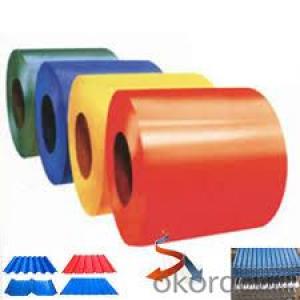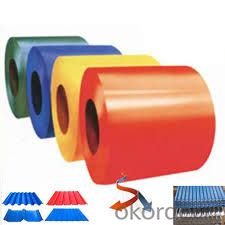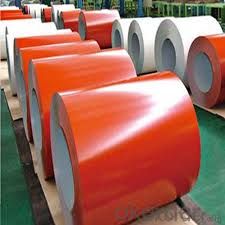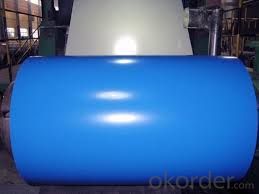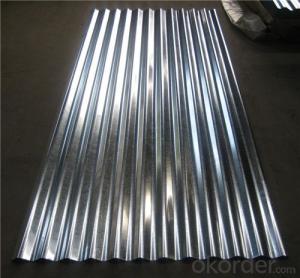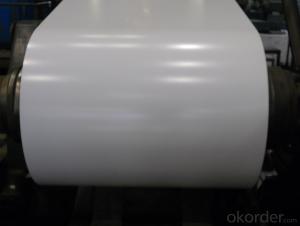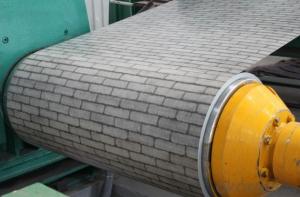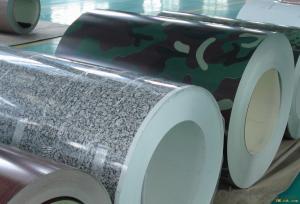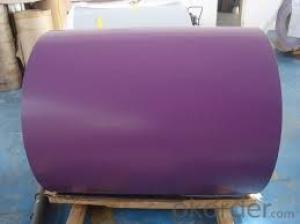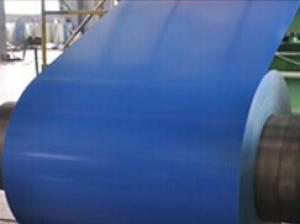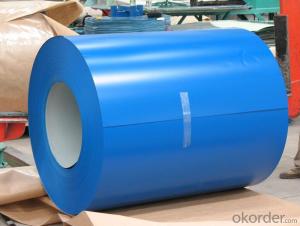Pre-painted Galvanized Steel Coil/Aluzinc Steel Coil for outdooe and in door
- Loading Port:
- Shanghai
- Payment Terms:
- TT OR LC
- Min Order Qty:
- 25 m.t.
- Supply Capability:
- 9000 m.t./month
OKorder Service Pledge
OKorder Financial Service
You Might Also Like
Product Description
Product | Galvanized | PPGI | Contour plate
| Camouflage plate | |
Certificate | ISO9001,ISO14001 | ||||
Standard | ASTM A526 JIS G3302 | ASTM A525 JIS G3312/3322 | - - | - - | |
Gade | CGCC/CGLCC CGCH/CGLCH CGC340-570 CGLC400-570 | SGCC/CS/DX51D SGCH | - - - - | - - - - | |
Model | Thick:0.11-1.0mm Width:600-1250mm | Thick:0.14-3.5mm Width:600-1250mm | Thick:0.14-3.0mm Width:600-1250mm | Thick:0.14-3.5mm Width:600-1250mm | |
Type | Roil/Coil Sheet/Plate Corrugated Sheet | Roil/Coil Sheet/Plate Corrugated Sheet |
Corrugated Sheet | Roil/Coil Sheet/Plate Corrugated Sheet | |
Coil Weight | 3-8t | ||||
Surface Finish | Regular Spangle | Pre-painted | Pre-painted | Pre-painted | |
Application | Roofing,Structural,Commercial use,Household Applicnce,Industry,Others | ||||
Special Application
| Wear resdentant steel,High-strength-steel plate | ||||
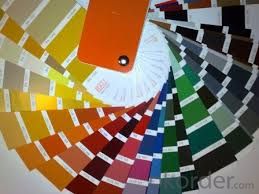
Name | GI / GL / PPGI / PPGL |
Full name | Galvanized ,Galvalume,Pre-paited galvanizing,Pre-paited galvalume |
Basic material | Cold Roll |
Color of the PPGI and PPGL | Any color in RAL |
Standard | AISI, ASTM, BS, DIN, GB, JIS |
Spangle | Normal / Min / Zero |
Brand Name | |
Thickness | 0.6mm |
Width | 600mm to 1250mm |
Length | According to customers |
Surface Treatment | Hop-dipped Galvanized |
AZ coating | 50-275g/m2 |
Spangle | Normal/Min/Zero |
Minimum order | 25 Metric Tons |
Place of Origin | Shandong, China(Mainland) |
Packing | Fully Applicable for exporting seaworthy packing of horizontal type on wooden skids |
Price terms | FOB Qingdao |
Terms of payment | T/T, L/C or T/T and L/C |
Delivery Detail | within 7-25 days after receiving pre-payment (as per the order quantity) |
Coil ID | 508mm/610mm |
Coil Weight | 3-5 tons |
Supply Ability | 30000MT per month |
Application | Construction Structure, roofing, commercial use, household appliance, industry- |
- Q: rust is not a issue. i was looking a D2 steel but heard story's of it chipping and breaking
- The very best is Damascus steel or the composite samari blade. Talk to the American Bladesmith Society if you are interested in forging your own or buying a forged blank and making the knife yourself. D2 and other similar tool steels are generally not a good choice because they can not obtain very high hardness but they should be tough (resistant to cracking) if they were heat treated properly. There are more ways to heat treat wrong than there are to heat treat right. Although you say rust is not an issue, 440 stainless steel is commonly used for commercial knives, it does not rust, holds a good edge, and is pretty tough.
- Q: my sister is making rolls and we have no idea what steel cut oats are. can someone please help with this?
- It does NOT look or cook like oatmeal but is made from the same grain. It takes much longer to cook since it is a whole grain, and tastes very good by the way. If you hate the slimy feel of oatmeal, this is the one to try, with all the same nutritional goodness of oatmeal. You can find it in most grocery stores in the hot cereal aisle. EDIT: you are right Mnt. Camp, steel cut is better that the regular oatmeal.
- Q: When steel is cast, does it become weaker/more brittle or anything of this nature? what are the side effects of steel casting on the steel itself?How can you correct these?
- It contains too many air bubble spacing and too many impurity that make it easily to be broken apart. Melt it down again with high heat to remove most impurity, after this process,it becomes iron.
- Q: Cast steel welding
- I Use these for cast iron, www.yms .uk/welding-rod-small-pack/2.5mm-cast-iron-welding-rod-small-pack/1951/11612/detail.asp they are expensive when compared to welding rods for steel but i find that normal steel ones dont work on cast iron
- Q: What are the different methods of coil joining for steel coils?
- There are several different methods of coil joining for steel coils, each with its own advantages and limitations. Some of the commonly used methods include: 1. Welding: This is one of the most popular methods of coil joining. It involves using heat to melt and fuse the edges of the steel coils together. Welding can be done using various techniques such as arc welding, resistance welding, or laser welding. It provides a strong and durable joint, but it can be time-consuming and may require skilled operators. 2. Mechanical fastening: This method involves using mechanical fasteners like clips, staples, or bolts to join the edges of the steel coils. Mechanical fastening is relatively quick and easy, and it allows for easy disassembly if required. However, it may not provide as strong a joint as welding and can be susceptible to loosening over time. 3. Adhesive bonding: Adhesive bonding involves using a suitable adhesive or glue to bond the edges of the steel coils together. This method provides a strong and uniform joint, and it can also help to seal and protect the joint from corrosion. However, adhesive bonding may require surface preparation and curing time, and it may not be suitable for high-temperature applications. 4. Interlocking or tongue-and-groove joints: This method involves shaping the edges of the steel coils in a way that they interlock or fit together like a puzzle piece. Interlocking joints provide good alignment and can be easily assembled and disassembled. However, they may not provide as strong a joint as welding or mechanical fastening. 5. Coil-overlapping: In this method, the edges of the steel coils are overlapped and clamped together using mechanical means. Coil-overlapping is a simple and cost-effective method, but it may not provide a strong joint and can result in uneven coil edges. It's important to consider factors such as the application requirements, strength requirements, cost, and production efficiency when choosing the appropriate method of coil joining for steel coils.
- Q: What are the end uses of galvanized steel coil? What is the market like for this raw material? Would something like this be expensive?Also can you explain: PPGI.And the following specifications; what do they mean/represent?Required Composition :Thickness- 0.23mmCarbon- Max. 0.01%Manganese- Max. 0.20%Phosphorous- Max. 0.05%Sulphur- Max. 0.01%Silicon- ABT. 2.80 - 3.50%CRGO Quality- Prime QualityThanks
- Steel coil is the name given to thinner sheet steel when it is manufactured - it comes out of the machine and is formed into a coil for ease of handling storage and transportation. Thin sheet steel is used for plenty of stuff. It can be slit (cut) into thin strips as well as just cropped and used at one of the standard lengths x widths it leaves the mill. There is a big market for this material. It is used in many construction and engineering applications for things like ducting, boxes, gutters, down pipes, flashings, panels, car bodies etc., anything made of thin steel Galvanising is a flash coating of zinc which improves it's corrosion resitance. Cost wise it is a relatively cheap material. The chemical composition of steel varies, it is mostly iron but has various other elements added or present as impurities that change it's characteristics, depending on the end use. These additional elements can be selected to give better weld ability, hardness, tensile strength, corrosion resistance, flexibility and so on. In many applications excess of these chemicals is undesirable. For example sulphur and carbon are generally better at lower levels. The chemical composition data is contained in a material data sheet and expressed as a percentage of the chemical present and which gives the composition of a particular batch of steel, allowing it to be selected for particular applications and traced for quality assurance purposes. The list you have there shows presence and quantity of other elements in a particular batch of coil. The thickness is 0.23mm, quite thin.
- Q: For example, (and this is weird) if I were wearing a steel collar and I needed some way to remove it, with limited supplies.Force is difficult because it would be around my neck.Chemical cominations are great- but they have to use VERY common products. And I'm not sure what to use.Other ideas?
- Your best bet would be a grinding wheel attached to a small electric motor. Even if you slipped, your skin is too soft to be cut by the dull wheel. Steel, however, is easily cut. But perhaps you don't have access to electricity or pressurized air to run such a tool. In that case, a simple file would work well, though you'd be somewhat more likely to injure yourself. If you had no tools, but access to whatever chemicals you wanted, you could try a weak acid. This would take a long time, and require constant scrubbing to bring fresh acid into the pits in the metal, but it would eventually eat through the collar.
- Q: How are steel coils used in the manufacturing of industrial pumps?
- Steel coils are used in the manufacturing of industrial pumps as they are typically used to construct the pump housing and impellers, providing the necessary strength and durability for handling high-pressure fluids and withstanding harsh operating conditions. The steel coils are processed and shaped into various components, ensuring the structural integrity and reliability of the pump, ultimately contributing to its efficient operation and long lifespan.
- Q: Ok, so im gonna get my tragus pierced and i was wondering which is better, titanium or stainless steel. I hear like everyone uses stainless steel , but is titanium better?Thanks
- It seems like less people are allergic to titanium than surgical grade steel.
- Q: What are the different types of steel coil slitting knives?
- There are several different types of steel coil slitting knives, including circular slitting knives, straight slitting knives, and crush-cut slitting knives. These knives are used for precision cutting and slitting of steel coils into narrower strips or sheets. Circular slitting knives feature a circular shape with sharp edges, while straight slitting knives have a straight cutting edge. Crush-cut slitting knives have a unique design that allows them to crush and cut the material simultaneously. Each type of knife is used for specific applications and offers different advantages depending on the desired outcome.
Send your message to us
Pre-painted Galvanized Steel Coil/Aluzinc Steel Coil for outdooe and in door
- Loading Port:
- Shanghai
- Payment Terms:
- TT OR LC
- Min Order Qty:
- 25 m.t.
- Supply Capability:
- 9000 m.t./month
OKorder Service Pledge
OKorder Financial Service
Similar products
Hot products
Hot Searches
Related keywords
